前言:昨天講解完了雜湊法的定義和,今天要來把它實際創建出來,這次用到的雜湊法要用之前學過的鏈結串列來實現,如果忘記相關技術的可以回去看看喔!
廢話不多說,開始實作!!!
先建立雜湊函式的整體架構函式。
接著建立鏈結串列的節點。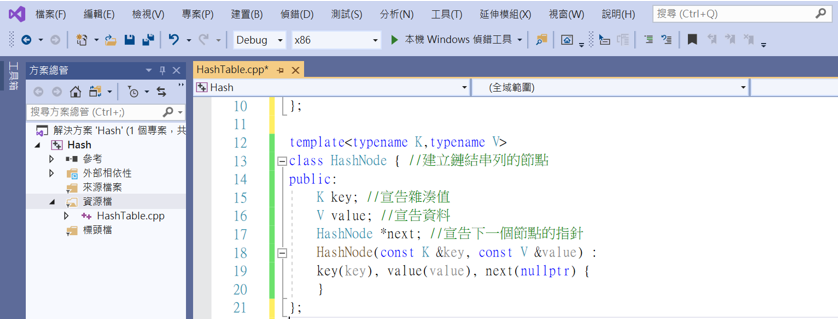
第三步要撰寫雜湊表,查詢、插入、修改、刪除都寫在這裡面,所以這一整段比較複雜。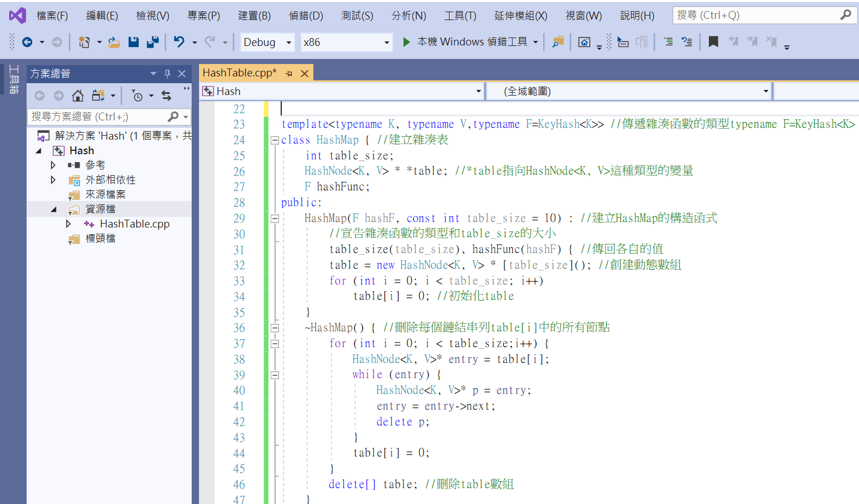
首先是第一個查詢的部分。
插入和修改比較類似,所以都寫在put裡面。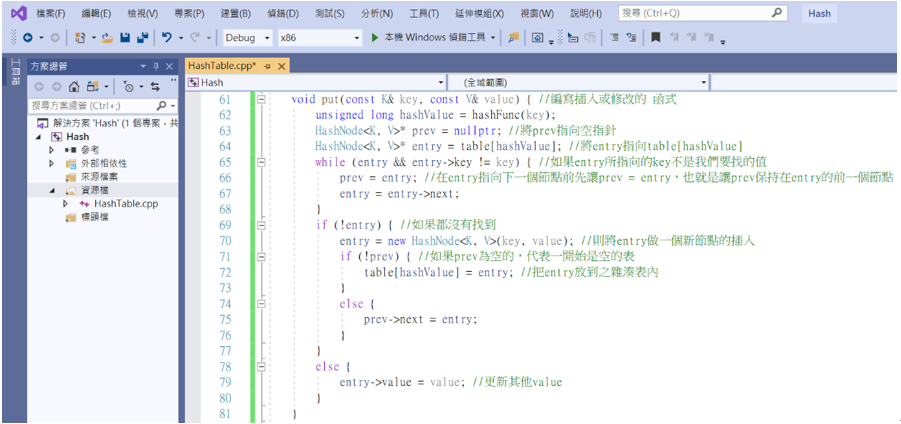
最後一個就是刪除。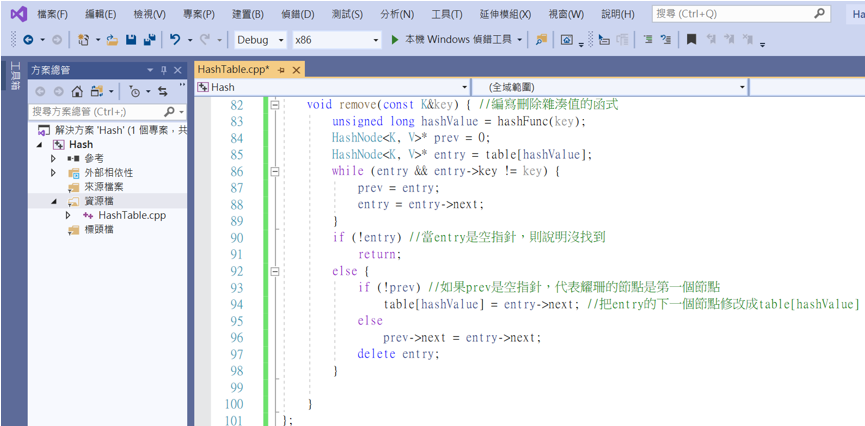
整體的架構完成得差不多了,可以先執行看看結果跑不跑得出來。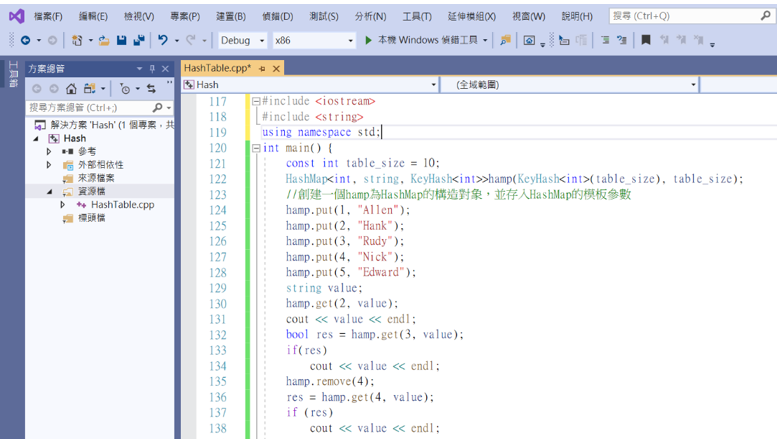
將五筆資料存入後,先用程式碼顯示第二三筆資料,然後把第四筆資料刪除後就無法顯示出來,所以剛剛撰寫的基本功能都可以正常運作。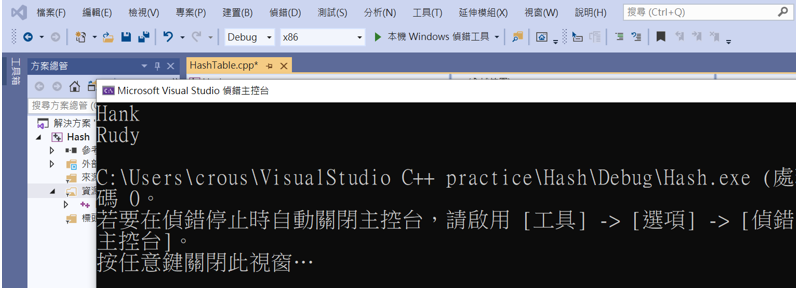
接著來嘗試做做看學生雜湊表。
這樣的做法可以比較統一資料儲存的格式,先寫好輸出的模板也可以少寫東西在主程式碼中。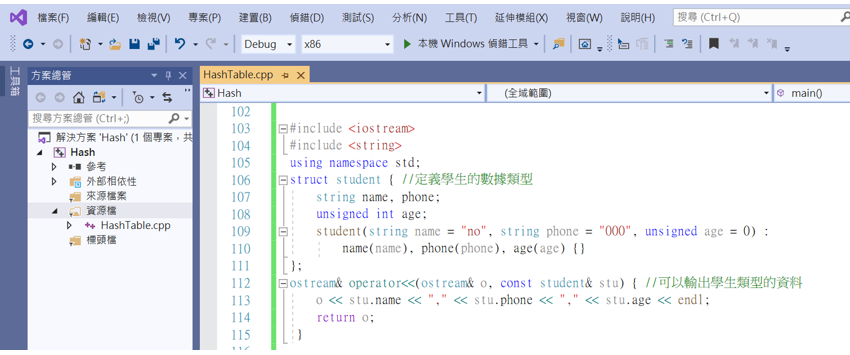
接下來簡單測試一下!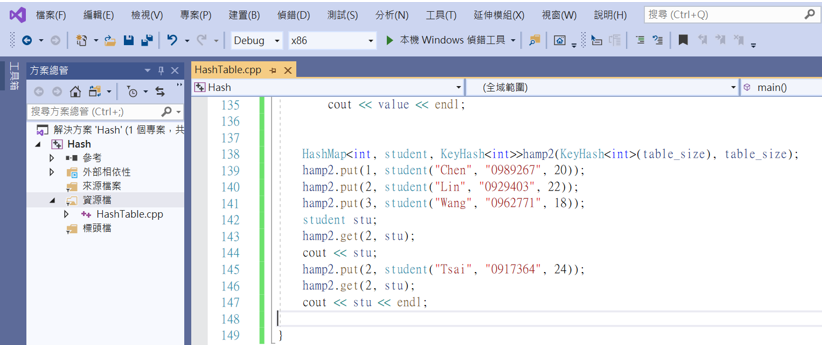
儲存三筆學生的資料,先顯示二號林同學的資料,將它修改成蔡同學程式也能執行。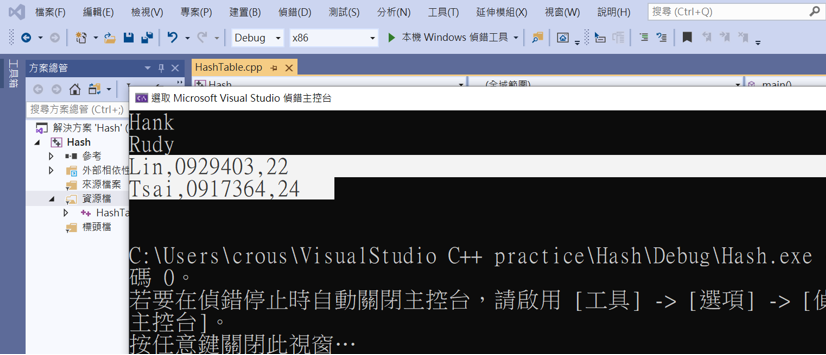
本日小結:今天的實作內容先到這邊為止,雖然只有一個基本的概念,但是就有不少程式碼,當初在研究的時候也花了很多時間。其實在第一次接觸到雜湊的時後,我覺得是資料結構和演算法中比較令我頭痛的,很多複雜的名詞和概念讓我在學習時吃了不少苦頭,經過這兩篇文章的整理,確實有對雜湊更了解一些。在實作雜湊法的時候,想想要怎麼利用雜湊函式得到雜湊值,並尋找出我們要的value,以這樣的方式思考會必較好喔٩(✿∂‿∂✿)۶
template<typename K>
struct KeyHash {
KeyHash(const unsigned long table_size) //建立雜湊函式的構造函數
:table_size(table_size) {}
unsigned long operator()(const K& key) const {
return static_cast<unsigned long>(key) % table_size; //將key強制轉換成unsigned long型別
} //並取除以table_size的餘數
private:
unsigned long table_size; //unsigned long資料型別的一種,類似於int
};
template<typename K,typename V>
class HashNode { //建立鏈結串列的節點
public:
K key; //宣告雜湊值
V value; //宣告資料
HashNode *next; //宣告下一個節點的指針
HashNode(const K &key, const V &value) :
key(key), value(value), next(nullptr) {
}
};
template<typename K, typename V,typename F=KeyHash<K>> //傳遞雜湊函數的類型typename F=KeyHash<K>
class HashMap { //建立雜湊表
int table_size;
HashNode<K, V> * *table; //*table指向HashNode<K, V>這種類型的變量
F hashFunc;
public:
HashMap(F hashF, const int table_size = 10) : //建立HashMap的構造函式
//宣告雜湊函數的類型和table_size的大小
table_size(table_size), hashFunc(hashF) { //傳回各自的值
table = new HashNode<K, V> * [table_size](); //創建動態數組
for (int i = 0; i < table_size; i++)
table[i] = 0; //初始化table
}
~HashMap() { //刪除每個鏈結串列table[i]中的所有節點
for (int i = 0; i < table_size;i++) {
HashNode<K, V>* entry = table[i];
while (entry) {
HashNode<K, V>* p = entry;
entry = entry->next;
delete p;
}
table[i] = 0;
}
delete[] table; //刪除table數組
}
bool get(const K& key, V& value) { //編寫查詢方法,給定一個key,查詢一個value
unsigned long hashValue = hashFunc(key); //將hashFunc裡面的雜湊值傳入hashValue,可以想成雜湊表的地址
HashNode<K, V>* entry = table[hashValue]; //資照雜湊表的下標table[hashValue],取代成第一個節點的指針*entry
while (entry) { //當entry不是空指針
if (entry->key == key) { //如果key是我們要找的
value = entry->value; //則將value傳回entry所指向的value
return true;
}
entry = entry->next; //如果沒有找到,則把entry往下一個移,繼續此步驟
}
return false;
}
void put(const K& key, const V& value) { //編寫插入或修改的 函式
unsigned long hashValue = hashFunc(key);
HashNode<K, V>* prev = nullptr; //將prev指向空指針
HashNode<K, V>* entry = table[hashValue]; //將entry指向table[hashValue]
while (entry && entry->key != key) { //如果entry所指向的key不是我們要找的值
prev = entry; //在entry指向下一個節點前先讓prev = entry,也就是讓prev保持在entry的前一個節點
entry = entry->next;
}
if (!entry) { //如果都沒有找到
entry = new HashNode<K, V>(key, value); //則將entry做一個新節點的插入
if (!prev) { //如果prev為空的,代表一開始是空的表
table[hashValue] = entry; //把entry放到之雜湊表內
}
else {
prev->next = entry;
}
}
else {
entry->value = value; //更新其他value
}
}
void remove(const K&key) { //編寫刪除雜湊值的函式
unsigned long hashValue = hashFunc(key);
HashNode<K, V>* prev = 0;
HashNode<K, V>* entry = table[hashValue];
while (entry && entry->key != key) {
prev = entry;
entry = entry->next;
}
if (!entry) //當entry是空指針,則說明沒找到
return;
else {
if (!prev) //如果prev是空指針,代表耀珊的節點是第一個節點
table[hashValue] = entry->next; //把entry的下一個節點修改成table[hashValue]
else
prev->next = entry->next;
delete entry;
}
}
};
#include <iostream>
#include <string>
using namespace std;
struct student { //定義學生的數據類型
string name, phone;
unsigned int age;
student(string name = "no", string phone = "000", unsigned age = 0) :
name(name), phone(phone), age(age) {}
};
ostream& operator<<(ostream& o, const student& stu) { //可以輸出學生類型的資料
o << stu.name << "," << stu.phone << "," << stu.age << endl;
return o;
}
int main() {
const int table_size = 10;
HashMap<int, string, KeyHash<int>>hamp(KeyHash<int>(table_size), table_size);
//創建一個hamp為HashMap的構造對象,並存入HashMap的模板參數
hamp.put(1, "Allen");
hamp.put(2, "Hank");
hamp.put(3, "Rudy");
hamp.put(4, "Nick");
hamp.put(5, "Edward");
string value;
hamp.get(2, value);
cout << value << endl;
bool res = hamp.get(3, value);
if(res)
cout << value << endl;
hamp.remove(4);
res = hamp.get(4, value);
if (res)
cout << value << endl;
HashMap<int, student, KeyHash<int>>hamp2(KeyHash<int>(table_size), table_size);
hamp2.put(1, student("Chen", "0989267", 20));
hamp2.put(2, student("Lin", "0929403", 22));
hamp2.put(3, student("Wang", "0962771", 18));
student stu;
hamp2.get(2, stu);
cout << stu;
hamp2.put(2, student("Tsai", "0917364", 24));
hamp2.get(2, stu);
cout << stu << endl;
}
